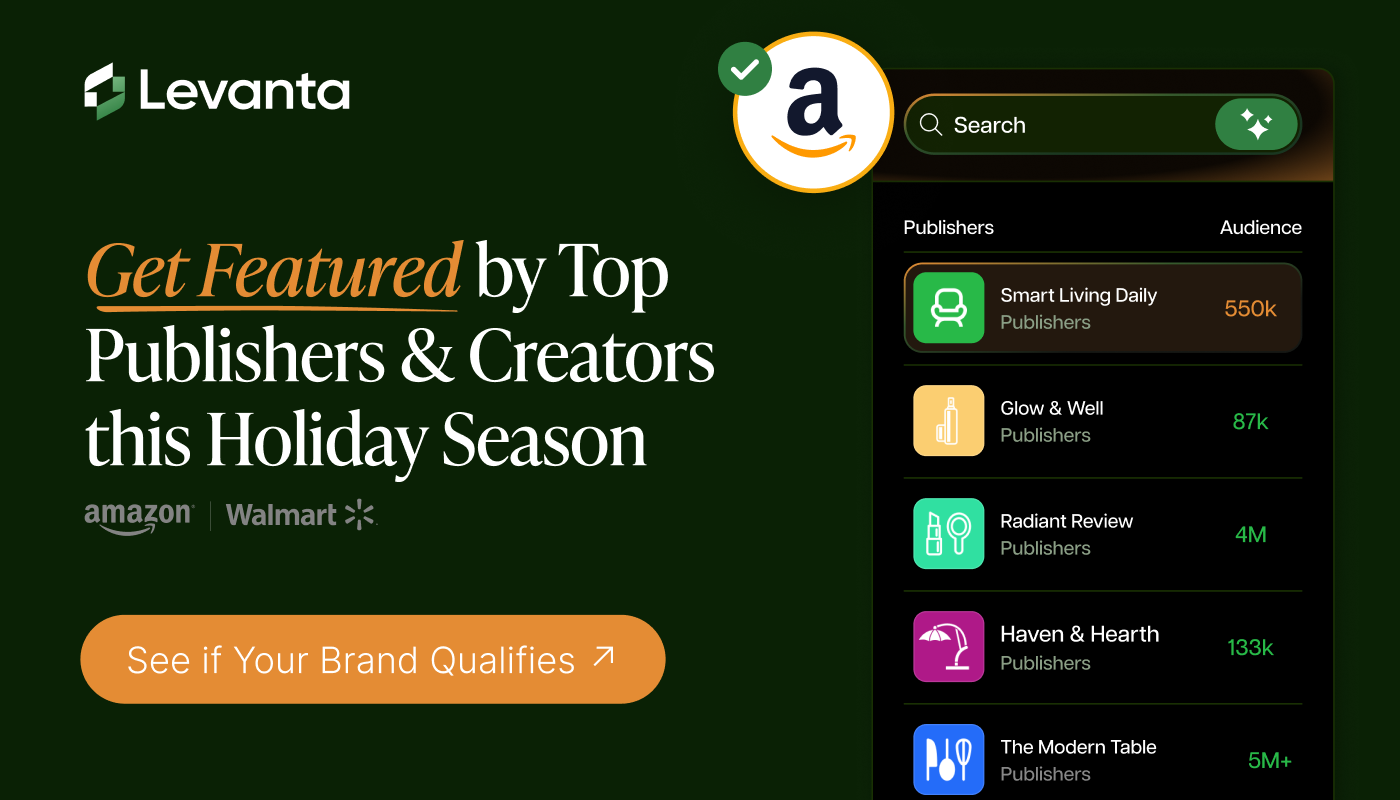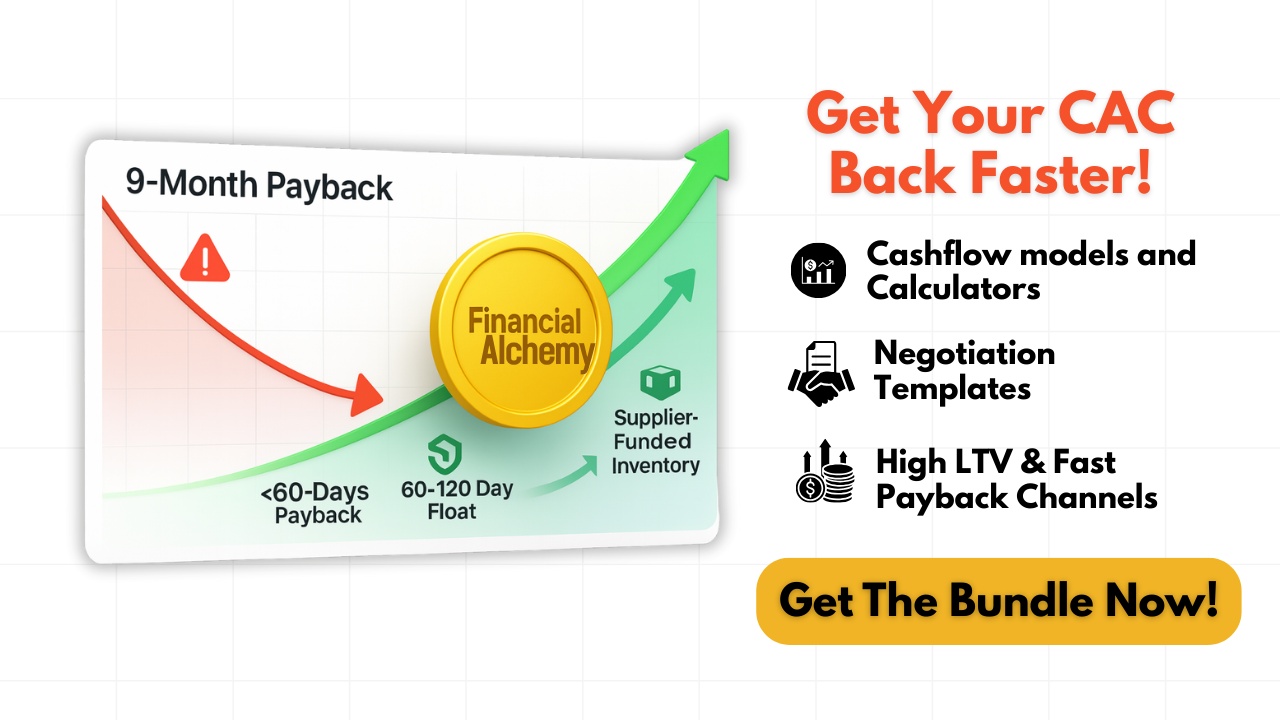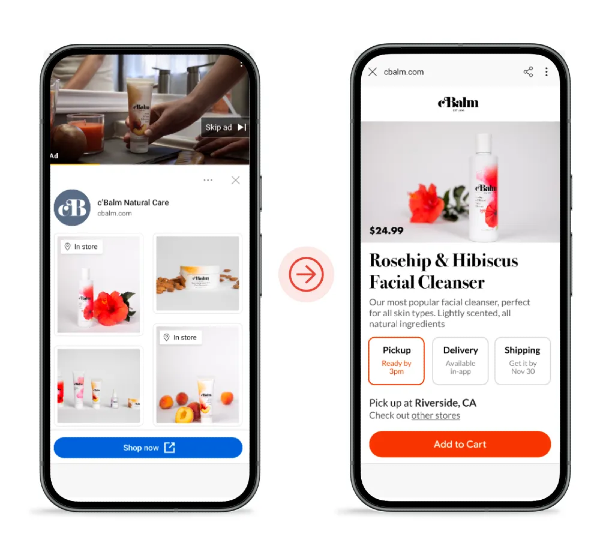The Silent CAC Multiplier
📉 Misaligned creative doubles spend without clear results, Google’s new ways to win over Holiday Shoppers, and more!

Hey there Smarty 👋
Are you geared up to catch the latest and greatest in quick shorts?
And just a quick heads-up! If you stumbled upon us through a friend, make sure to subscribe here! That way, you’ll never miss out on the trending shorts.

Together with Levanta
Only a Handful of Brands Get Featured This Season

This holiday season, top publishers are actively sourcing brands to feature in their gift guides, newsletters, listicles, reviews, and more, driving high-intent shoppers directly to Amazon storefronts.
Here’s why it matters:
- Marketplace brands are seeing a 5:1 conversion rate compared to DTC sites
- Millions of shoppers discover products through trusted publishers
Levanta is working directly with these publishers to introduce them to a small number of 7–9 figure brands.
If you qualify, your products could be featured in high-traffic placements that deliver predictable CAC and directly measurable sales.

📉 The Silent CAC Multiplier: Misaligned creative doubles spend without clear results.
Most ad teams fixate on improving the quality of their creatives. But the silent killer isn’t bad execution; it’s wrong placement. When a top-funnel visual is thrown at bottom-funnel buyers (or vice versa), Meta doesn’t just struggle to deliver results.
It wastes the budget trying to resolve a contradiction: “Who is this even for?”
The Real Tax: Format-Stage Misalignment
Creative doesn’t work in a vacuum. Meta’s delivery model interprets every ad you launch as a signal. Is this for discovery or conversion? Is it meant to entertain or persuade? Who is this most likely to resonate with, and where in their journey are they? If your media format doesn’t match your funnel goal, you’re not just underperforming, you’re paying a hidden penalty.
We call this the Creative Mismatch Tax: the extra CAC, CPM inflation, or spend waste caused by using the wrong format at the wrong funnel stage.
Common examples:
An aesthetic brand uses long-form video in TOF, CAC spikes to $28.
Same brand runs minimal static in TOF, CAC drops to $14.
A utility brand runs plain images in TOF, CTR tanks at 0.6%.
Same product shown in a 12-sec demo, CTR jumps to 2.2%.
The 3-Part Audit Framework
You don’t need more ad testing. You need a mismatch detection system across 3 axes:
1. Product Complexity Axis
- Aesthetic/Impulse → Visual Discovery → Use statics, carousels, GIFs.
- Utility/Explainer → Demonstration First → Use short-form video, animations, hooks.
2. Funnel Intent Axis
- TOF → Curiosity, Thumbstop, Visual Appeal
- MOF → Use-case clarity, brand vibe, functional tease
- BOF → Offer clarity, trust, UGC, product specs
If your ad screams “BUY NOW” but the viewer just met you, it’s a mismatch.
3. Format-to-Stage Fit Table

Final Test: The “Format Fingerprint Fit” Score
Before launching any new ad, ask: Does this format match the behavior needed at this stage? Does it align with the natural buying motion for this product category? Would it make sense even in a physical store in 1950? That’s your acid test. If not, your CAC isn’t just rising, you’re taxing your own media strategy with structural inefficiency.
Why It Matters
Everyone is optimizing thumbnails. Elite brands are optimizing fit-to-intent media sequencing.
This unlocks lower CAC, deeper creative iteration, and a sharper edge in crowded auction environments. The best-performing ads aren’t prettier; they're perfectly placed. Remove the Creative Mismatch Tax, and your funnel efficiency lifts without spending a dollar more.

Together with The Operator's Stack
If Your CAC Payback Takes 9 Months, You’ve Already Lost.

The fastest-growing brands in 2025 aren’t waiting for capital. They’re engineering <90-day CAC paybacks while pulling future revenue into today’s bank balance.
How? By stacking prepaid bundles, supplier-funded inventory, and extended payment terms that give them 60–120 days of float to redeploy into growth. That’s how ad dollars start compounding instead of draining.
Financial Alchemy gives you the exact playbooks, models, and calculators to make it happen. Inside, you’ll see:
- How Wayfair runs a 34-day cash cycle.
- Why Gymshark scaled without outside capital.
- The frameworks to identify high-LTV, fast-payback channels before your competitors.
And you won’t just get one book, you’ll also unlock:
- Networked Growth Engines – Community playbook, referral ROI calculator (Excel), and 4 partnership marketing templates.
- Rewriting the DTC Rulebook – Emotional Storytelling Framework, Brand Value Canvas, Owned Media Checklist, plus the Assumption Buster & Decision Matrix.
Start small, scale fast; these systems are designed to pay for themselves before the quarter ends.
Get your 3-in-1 bundle today and turn cashflow into your unfair advantage!

🎯 New Ways to Win Over Holiday Shoppers
Google is introducing AI-driven updates across Search, YouTube, and Merchant Center to help brands connect with consumers earlier in their shopping journey. These tools emphasize discovery, creative flexibility, and loyalty, all critical for the holiday season.

The Breakdown:
1️⃣ Meet Customers at Discovery - Over 60% of Google shopping searches now use broad, conversational phrases. AI Overviews and AI Mode place helpful ads alongside complex queries, while AI Max for Search enables one-click campaign optimization globally.
2️⃣ Turn YouTube Viewers into Buyers - Demand Gen now optimizes for sales across online, app, and in-store channels. Shoppable YouTube Masthead ads and a Creator partnerships hub help brands convert viewers into loyal customers.
3️⃣ Power Up Campaigns with Smarter Tools - Google Merchant Center is now offering AI-based demand insights, Product Studio expands creative options, and Asset Studio gains generative AI via Imagen 4. A single budget can now cover Search, Performance Max, and Shopping campaigns for 3–90 days.
4️⃣ Drive Loyalty and Personalization - New loyalty features in Performance Max and Standard Shopping showcase member-only pricing and benefits, supporting retention goals already yielding success for brands like Sephora.
These updates position Google as a full-funnel holiday marketing platform, enabling brands to capture intent early, personalize offers, and manage budgets effectively during peak shopping periods.

🚀Quick Hits
📦 The first impression isn’t the ad, it’s the box. Shipfusion’s $8,000 teardown revealed that half of the brands used custom packaging but only 36% branded interiors, leaving unboxing flat. Across categories, fulfillment is failing. Get the Cosmetics Delivery Files and fix the retention leaks.
📊 LinkedIn now tracks how many users save a post or send it via DM, giving creators clearer insights into real engagement and private sharing.
📰 Reddit introduced a free Reddit Pro for Publishers suite with article insights, RSS auto-import, and AI-driven community recommendations, helping media brands tap 110 million daily users as referral traffic patterns shift.
🎁 Deloitte projects U.S. holiday retail sales will grow just 2.9–3.4% to $1.61–$1.62T, the slowest since the pandemic, while e-commerce rises 7–9% to $305–$310.7B, powered by strong online deal-seeking.
📦 Blue Yonder’s survey shows 84% of global shoppers would stop buying from a retailer with tighter return rules, while 66% avoid purchases entirely when policies become strict.

That’s a wrap for today! Tell us your thoughts about today's content as we line up more Shorts! And don’t hesitate to share this with someone who’d adore it. 🥰
